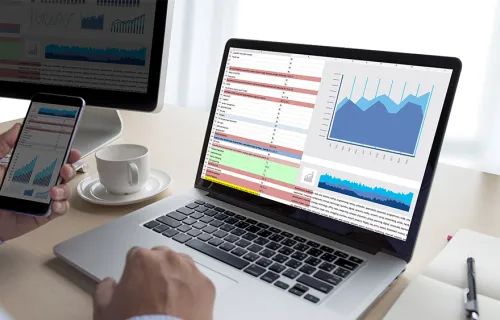We are into the third month of our home shelter orders for our state. If you are like me, it is hard to remember what it was like to be flying around the world delivering trainings, leading workshops, and meeting face to face with clients. As social creatures, we’d much rather to be face to face with our coworkers and friends than be cooped up in our homes with only video conferencing to connect us. This simple truth is a core principle to agile. But life and agile is about dealing with reality and making the best of the situation we are in.
In a previous blog, I discussed how lean and agile business leaders approach our new working and economic realities. While that blog focused more on strategic imperatives, this blog shares more immediate and tactical actions for lean and agile practitioners who still are working through how to respond to the current crisis.
Many agile IT initiatives are going on right now to improve systems that support the front lines of fighting this pandemic, and the economic challenges that come with it. So, how can these efforts move forward most effectively in a virtual world?
I suspect most of you are handling your team level activities quite effectively since virtual teams have been with us for years now. For teams of 5 to 11 people, good facilitation methods and good team norms come more easily, especially for meetings and activities lasting a couple hours or less. But, what about those 2 and 3-day sessions with more than a hundred participants, such as a Scaled Agile Framework (SAFe®) Program Increment (IP) planning ceremony? Making these events virtual is another story.
At CGI, we have been involved in several recent virtual PI planning meetings and virtual Inspect and Adapt (I&A) workshops (held at the end of each PI) involving hundreds of people. Following are some key lessons learned from these events.
Key elements of virtual PI planning: tooling and techniques
There are two vital areas to address when handling such large venues, virtually. The first is the tooling and second is the facilitation techniques. Let’s begin with the tooling. For large meetings, the two primary tools are web conferencing and web collaboration. Both must allow you to invite guests so your stakeholders, and potentially customers, can join your meetings and engage in the activities.
For web conferencing tools, here are 6 critical features for successful events:
- Audience management
Hosts must be able to control who can speak and who is muted. Often, you want only the presenter to talk and then open it up for questions. You want to allow three or four people to interchange with each other freely to encourage conversation and exchange of information.
- Multiple hosts
Effective audience management, above, requires having people who are completely focused on audience control while the facilitator focuses on the actual conversation.
- Breakout rooms
Program-level events include team breakouts for either team-level planning or group problem solving. It is critical to make it easy for your audience to form groups and break into their own conference calls. They need to be able to move freely from one breakout session to another, have their group conversations, and then return to where they were.
- Chat
While in breakouts, participants need the ability to chat with everyone from the larger audience. The breakouts must be “children” of the larger session.
- Broadcast
The host needs to be able to broadcast to all sessions and bring everyone back to the main session. Time management in these events is even more important in a virtual setting, to keep everything on track and manage time boxes.
- Survey/voting
A survey capability is vital for the confidence vote. You can’t rely on counting hands raised in videos. With more than 100 videos (if the network can handle it), it is too difficult to see everyone individually.
For web collaboration tools, here are 5 critical features for successful events.
- Virtual whiteboards
Facilitators need the ability to simulate sticky notes for collecting ideas or writing stories. The ability for people to brainstorm around a work area is vital to planning and problem solving. This is especially important for the breakout sessions. Everyone must be able to contribute simultaneously, seeing each other’s work in real time.
- Plan portability
Once the session is completed, teams need to port the information into their agile lifecycle management (ALM) tool, easily, whether it’s stories, risks, problems or business objectives. I recommend teams use their ALM tool if possible to build and present their plans. Most good ALM tools support these collaboration features.
- Dot voting
Once you have collected your ideas and organized them around affinity groups, you need to be able to prioritize your work. Dot voting is an effective way to do this.
- Shared spaces
The ability to work in teams while in a shared space is key to supporting breakout sessions. Teams may want the web conferencing to be isolated for their own use, but the workspace where people are building their PI planning boards should be visible to everyone.
- Whiteboard portability
Teams also need the ability to export whiteboards to formats that can be shared with the audience after the meeting.
Tips for facilitating large ceremonies virtually
Having good tools that provide the features described above will make facilitation easier, but the meeting can still become a train wreck if you have not thought through all the scenarios that you will have to manage in these ceremonies. Crowd management is critical. Here are some tips for handling this.
- Be sure to have all guests attend a tools-training session prior to the meeting. If this is your first virtual session, make sure all attendees are trained with the tools and even have them practice certain parts of the meeting.
- Make sure you have facilitators for all breakout sessions. All of your scrum masters should be well trained in facilitation, but you may need more facilitators than just your official scrum masters for every session.
- Have breakout rooms for your shared services, product managers, user experience (UX), system teams, etc., where the agile teams can come to ask questions. These folks should be wandering from virtual room to room in the collaboration tool but people would need to find these folks and will need to come to these shared teams calls to talk.
- Have spare breakout sessions where people can form work teams on the fly to collaborate.
- Have clear meeting guidelines presented at the start of the session and periodically at important times such as draft plan reviews. SAFe provides a good set of guidelines in their remote training teacher guides.
- Take more days with shorter sessions per day with plenty of breaks to keep the energy level high.
- Have people request permission to speak from the audience. Some tools have a virtual hand- raising feature, but chat can also be used for this.
- Use the lean coffee technique to get audience feedback (Thumbs up/down) about whether a conversation has gone on long enough.
- Keep notes taken in a place visible to the audience; your web collaboration tool works best for this.
- Have backup ways to do everything in case one of your technologies fails.
- Encourage all attendees to have at least two monitors; the host and facilitator will want three. This allows them to watch the web conference while also watching the web collaboration white board to view notes and even participate in adding notes to the session.
These program-level events are important not just for the results that come from them, but also for their team building aspects. No matter how good we get at being virtual, it will never replace the value of being together in person. Being able to shake hands, hug and share meals together is priceless for building relationships that are so critical to great teamwork. But while we are completely virtual, I hope you find this information helpful.





